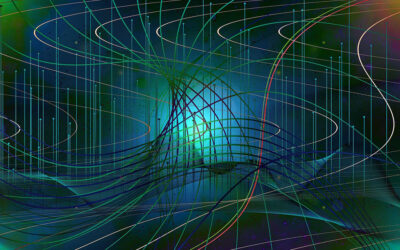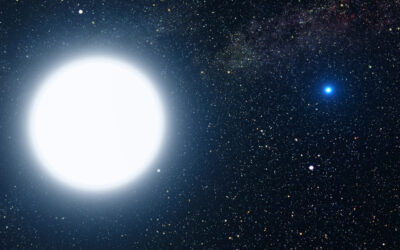Two theoretical physicists believe that string theory could provide a potential solution to one of cosmology’s greatest mysteries: the surprisingly small density of dark energy.
Dark energy is the term scientists use to describe the mysterious force driving the accelerated expansion of the Universe. For decades, researchers have sought to uncover its nature without much success. This is because dark energy doesn’t emit or interact with light, making it incredibly difficult to detect and study directly. However, a recent theory offers a new explanation.
This theory suggests that dark energy can be understood if we look at the Universe through the lens of string theory, which is a complex idea that tries to explain how everything in the Universe is connected.
According to this theory, there are extra dimensions beyond the ones we can see. While scientists used to think these extra dimensions were incredibly tiny, the new theory proposes that one of these dimensions could actually be as large as a micron, which is still very small but much bigger than previously thought.
“[String theory] ideas have been combined with observational data to suggest the existence of a mesoscopic extra dimension of roughly micron size, the ‘dark dimension’,” the researchers wrote in their study.
The dark energy conundrum
The accelerated expansion of the Universe, first discovered in the late 1990s, can only be explained by proposing the existence of a mysterious entity known as dark energy, which drives this acceleration. This energy is thought to permeate all of space and acts as a repulsive force, countering gravity and driving galaxies apart at an ever-increasing rate.
While its existence is hinted at through this observational evidence, the origin of dark energy remains elusive, as it cannot be studied in a laband manifests only on the cosmic scale.
Currently, the most widely accepted explanation is that it arises from quantum vacuum fluctuations. According to quantum theory, the vacuum of space is not truly empty but instead teems with particles and antiparticles that constantly appear and annihilate each other. These fluctuations are thought to give rise to an intrinsic energy of the vacuum.
However, there’s a major problem: when scientists calculate the energy density of these fluctuations using general relativity and the Standard Model of particle physics, the result is a value around 10120 times larger than what is observed.
This discrepancy, known as the “cosmological constant problem,” is one of the biggest challenges in modern theoretical physics.
String theory as a solution
In an attempt to resolve this issue, Ivano Basile and Dieter Lüst from Ludwig Maximilians Universität München and the Max Planck Institute for Physics turned to string theory.
This theoretical framework seeks to unify all fundamental forces — including gravity — by replacing point-like particles with one-dimensional strings. The different vibrational modes of these strings correspond to the various particles observed in nature.
String theory requires spacetime to have ten dimensions: nine spatial and one temporal. Since we only observe three spatial dimensions in everyday life, physicists have hypothesized that the additional six dimensions are “compactified”, meaning they are curled up on scales so small that they are undetectable.
Traditionally, these extra dimensions are thought to be on the order of the Planck length, a scale believed to be the characteristic size at which quantum gravitational effects become significant.
Despite its elegance, this approach has failed to explain the observed value of dark energy. Basile and Lüst have elaborated on a bold alternative: what if one of the extra dimensions is not Planck-sized but instead much larger — on the order of a micron (10-6 cm), which is 29 orders of magnitude larger.
The dark dimension
In their study, published in Progress of Physics, they explored how the size of extra dimensions affects the value of dark energy. The team calculated how strings created and annihilated in the vacuum interact within a higher-dimensional space and discovered that if one of these dimensions — dubbed the ‘dark dimension’ — is approximately a micron in size, the resulting energy density aligns with the observed value of dark energy.
This surprising result opens the door to a new interpretation of string theory’s compactified dimensions. If the dark dimension exists, it would mean that the scale of quantum gravity — the energy scale at which gravitational interactions become quantum mechanical — could be much smaller than previously believed.
Moreover, this lower quantum gravity scale might be accessible to experiments conducted with upcoming high-energy particle colliders, such as the proposed Future Linear Collider at CERN. This would provide a unique opportunity to test string theory directly.
“This connection between deep theoretical principles and [experimental] possibilities opens an exciting window into near-future experimental tests of string theory and possibly quantum gravity in a broader sense,” the researchers wrote.
Challenges and next steps
While their results are promising, Basile and Lüst findings are preliminary and should be regarded as order-of-magnitude estimates rather than precise predictions. One limitation of their work is that they did not account for the exact shape of the other compactified dimensions, which remains unknown.
Future research will need to refine these calculations by incorporating more detailed models of string interactions and the geometry of higher-dimensional spaces. As observational data on the universe’s accelerated expansion becomes increasingly precise, theoretical models will need to match this accuracy to remain viable.
If the prediction of a micron-scale dark dimension and a lower quantum gravity scale proves correct, it could revolutionize our understanding of the universe. Quantum gravity, a field long thought to be out of reach for experimental verification, might finally become accessible.
Reference: Ivano Basile and Dieter Lüst, Dark Dimension With (Little) Strings Attached, Progress of Physics (2024). DOI: 10.1002/prop.202400265
Feature image credit: StockSnap on Pixabay

















